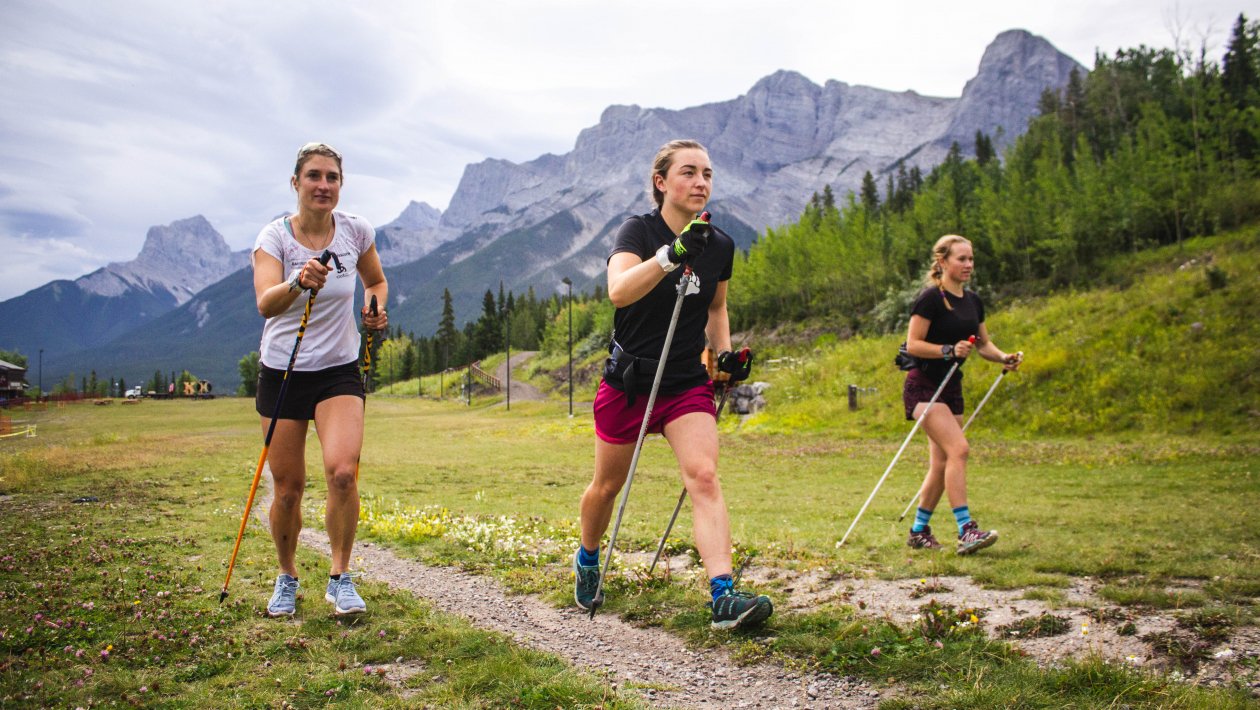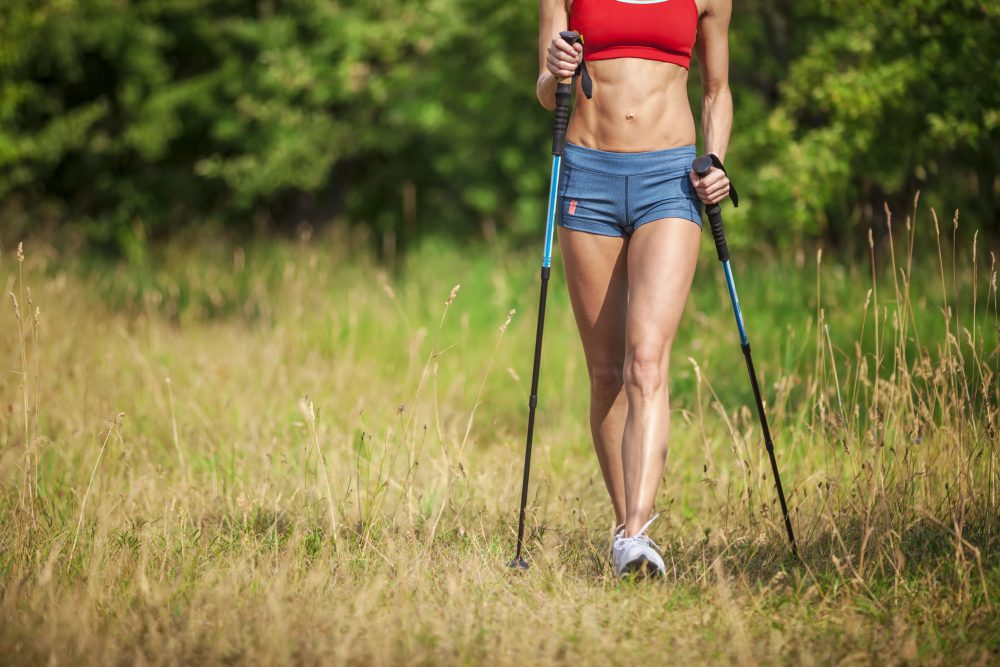
Nordic walking is a total body version of walking that can be enjoyed both by non-athletes as a health-promoting physical activity, and by athletes as a sport. The activity is performed with specially designed walking poles similar to ski poles. Nordic Walking is an enhancement of ordinary walking – it makes something we learn to do as babies …. twice as effective!
Nordic Walking uses poles in order to add two major benefits to walking. The use of poles means the upper body muscles are used as well as the legs. The poles help to propel the walker along – this means he/she works harder than usual yet the support given by the poles makes it feel easier!
Nordic Walking is a specific fitness technique and is not to be confused with trekking, hill walking or trail running as the poles are not planted in front of the walker/runner but in a specific way that increases the use of the upper body. It can be done by anybody, anywhere and does not require expensive equipment or clothing.
Nordic Walking is the fastest growing fitness activity in the world and is used by individuals, personal trainers, health clubs, physiotherapists, doctors and health promoters because it is highly effective, affordable and FUN!
Nordic Walking technique MUST be learnt correctly if the participant is to get the most out of the activity – the full Health technique that ensures the whole body works efficiently is only taught by NWUK qualified Instructors.
Nordic walking (original Finnish “Sauvakävely”) is fitness walking with specially designed poles. While trekkers, backpackers and skiers had been using the basic concept for decades, Nordic Walking was first formally defined with the publication of “Hiihdon lajiosa” (translation: “A part of cross-country skiing training methodic”) by Mauri Repo in 1979.( Works related to Hiihdon lajiosa at Wikisource.) Nordic Walking’s concept was developed on the basis of off-season ski-training activity while using one-piece ski poles.
For decades hikers and backpackers used their one-piece ski poles long before trekking and Nordic walking poles came onto the scene. Ski racers deprived of snow have always used and still do use their one-piece ski poles for ski walking and hill bounding. The first poles specially designed and marketed to fitness walkers were produced by Exerstrider of the USA in 1988. Nordic Walker poles were produced and marketed by Exel in 1997. Exel coined and popularized the term ‘Nordic Walking’ in 1999.
Benefits of Nordic Walking

Compared to regular walking, Nordic walking (also called pole walking) involves applying force to the poles with each stride. Nordic walkers use more of their entire body (with greater intensity) and receive fitness building stimulation not present in normal walking for the chest, lats, triceps, biceps, shoulder, abdominals, spinal and other core muscles that may result in significant increases in heart rate at a given pace. Nordic walking has been estimated as producing up to a 46% increase in energy consumption, compared to walking without poles.
Equipment used in Nordic Walking
Nordic walking poles are significantly shorter than those recommended for cross-country skiing. Nordic walking poles come in one-piece, non-adjustable shaft versions, available in varying lengths, and telescoping two or three piece twist-locking versions of adjustable length. One piece poles are generally stronger and lighter, but must be matched to the user.
Telescoping poles are ‘one-size fits all’, and are more transportable.
Nordic walking poles feature a range of grips and wrist-straps, or rarely, no wrist-strap at all. The straps eliminate the need to tightly grasp the grips. As with many trekking poles, Nordic walking poles come with removable rubber tips for use on hard surfaces and hardened metal tips for trails, the beach, snow and ice. Most poles are made from lightweight aluminium, carbon fiber, or composite materials. Special walking shoes are not required, although there are shoes being marketed as specifically designed for the sport.
Technique of Nordic Walking
The cadences of the arms, legs and body are, rhythmically speaking, similar to those used in normal, vigorous, walking. The range of arm movement regulates the length of the stride. Restricted arm movements will mean a natural restricted pelvic motion and stride length. The longer the pole thrust, the longer the stride and more powerful the swing of the pelvis and upper torso.
Nordic Walking Organisations:
- World Original Nordic Walking Federation – ONWF
- International Nordic Walking Association – INWA
- International Nordic Fitness Sports Association – INFO
- Korea Nordic Walking Federation – KNWF
- Nordic Walking Organisation – NWO
- Indian Nordic Walking Organisation – INWO
- Italian Nordic Walking Association – ANI
International Nordic Walking Federation (INWA) is the official worldwide international federation promoting Nordic Walking and was founded in Finland in 2000. INWA is the only international organisation authorized by the creators of Nordic Walking to promote, develop and safeguard the principles and characteristics of Nordic Walking worldwide. In co-operation with professionals in sports, health and fitness, INWA develops innovative teaching methods and educational programs in Nordic Walking. INWA also collaborates with the scientific and medical communities offering research guidelines. INWA has over 20 official member organisations. INWA Nordic Walking Instructors have been certified in over 40 countries around the world.
Nordic Walking uses specially designed poles to enhance your natural walking experience. With a technique that is similar to the upper body action of classic cross country skiing, Nordic Walking becomes a genuinely whole body exercise that can be enjoyed at many levels, from walking for health to athletic Nordic running. More than 10 million people globally enjoy this outdoor activity all year round.
How Nordic Walking benefit your body
Nordic Walking combines the simplicity and accessibility of walking with simultaneous core and upper body conditioning similar to Nordic skiing. The result is a full body workout,
which means that you:
- burn up to 46% more calories compared to walking without poles
- release tension in the neck and shoulders
- improve your posture and gait
- strengthen your back and abdominal muscles
- reduce the impact on the joints
And because Nordic Walking doesn’t feel like hard work you’ll be happy to walk further and for longer.
“In 6 months I lost a stone, waved goodbye to the bingo wings, rediscovered my waistline and I definitely have less cellulite, even my husband said my bum was smaller” Nordic Walking Mum of two
“Sitting at my computer all day kills my back. After my evening nordic walking class, I’ve really relaxed, its like a massage for my neck and shoulders and I sleep so much better” Nordic Walking Site Manager
Nordic Walking is a very accessible activity and something that can be shared by people of different fitness levels. It’s an ideal activity for people who haven’t exercised for a while or who dislike traditional sports or gym activities. An injured person can use the poles to support and guide, working to improve fitness as part of their rehabilitation. Athletes can use Nordic Walking for cross training and incorporate Nordic running. Community groups find it a sociable way to keep fit. If you’d like to shed a few pounds, then Nordic Walking is an enjoyable way to do this. It’s great for fitness enthusiasts who like to try new things. Whatever your age from 8 to 80+, you’ll probably enjoy discovering the benefits of Nordic Walking that improve your quality of life.
Disclaimer
The Content is not intended to be a substitute for professional medical advice, diagnosis, or treatment. Always seek the advice of your physician or other qualified health provider with any questions you may have regarding a medical condition.